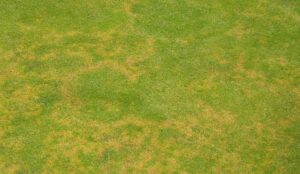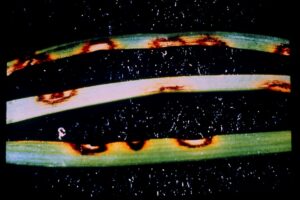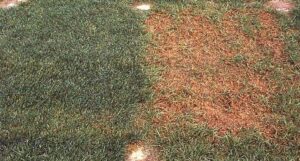Main Content
The annual event, held on July 29-30, highlighted ongoing turfgrass research at Rutgers and was attended by over 800 industry professionals! Read the full story here.
The annual event, held on July 29-30, highlighted ongoing turfgrass research at Rutgers and was attended by over 800 industry professionals! Read the full story here.
Brown Ring Patch (aka Waitea patch) is starting to show up on golf course putting greens at this time. This disease is caused by the fungus Rhizoctonia circinata var circinata and typically develops during warm weather from April through June. Symptoms start as small yellow rings (0.25-2 inches wide) with green grass in the center and can ultimately reach a foot or more in diameter. The yellow rings can turn an orange or brown color as the disease progresses. Although the disease rarely kills turf, affected areas are extremely slow to heal. For best results, apply Medallion, polyoxin-D (e.g., Affirm or Endorse), ProStar, one of the QoI fungicides (e.g., Heritage or Insignia), Trinity, Triton Flo, or Torque now and repeat in two to three weeks to limit disease development later this spring. Unlike yellow patch, the brown ring patch fungus can degrade the thatch in infected areas so several fungicide applications are typically required to prevent significant damage. Seedhead suppressants (e.g., Proxy + Primo) may enhance disease severity. Therefore, be sure to initiate a preventive brown ring spot fungicide program in areas where this disease has been troublesome and seedhead suppressants have been applied. For more information on brown ring patch, click here.


The leaf spot phase of this disease, caused by the fungus Drechslera poae, is apparent on susceptible Kentucky bluegrass turf at this time.

To prevent severe damage from the melting-out stage of this disease during the next six weeks, avoid heavy applications of nitrogen in the spring (not more than 0.5 lb N / 1,000 sq. ft. / application of quick-release, water soluble formulations such as urea or ammonium nitrate), maintain the cutting height at or above 2 to 2-1/2 inches, remove excess thatch, and apply Armada, Compass, Disarm, Headway, Heritage, Insignia, mancozeb, Medallion, Tartan, or Velista now, per manufacturer’s recommendations. Avoid the use of certain acropetal penetrant fungicides (e.g., benzimidazoles) this spring in areas with a history of leaf spot and melting-out, since these fungicides may intensify symptom expression.
The Rutgers Golf Classic will be held on May 5, 2014 at the Fiddlers Elbow CC in Bedminster Township, NJ. This is a major regional turf research fundraiser that has attracted golfers from eight states and has raised over $1.3 million for the Rutgers Turf Research Program over the past 18 years. To be a part of this great opportunity to support turf research and extension programs at Rutgers, access on-line registration information at www.njturfgrass.org or call the New Jersey Turfgrass Foundation at (973)-812-6467.